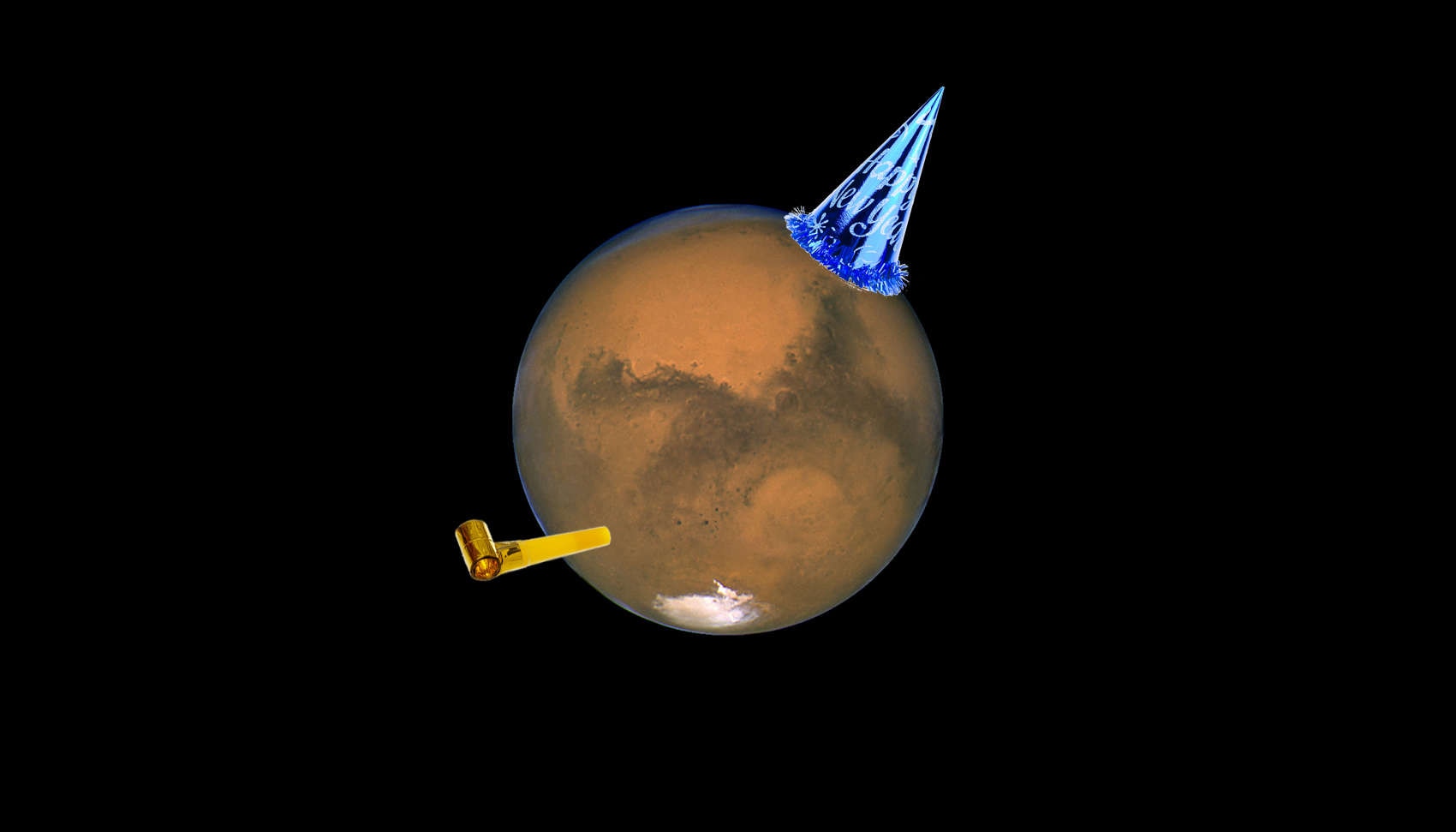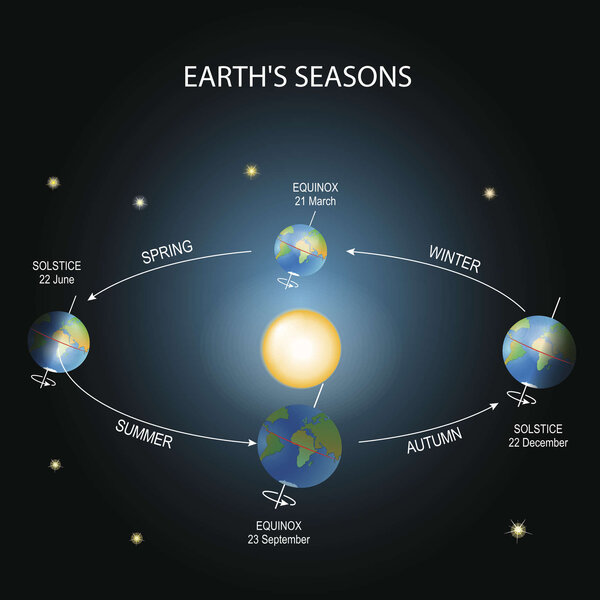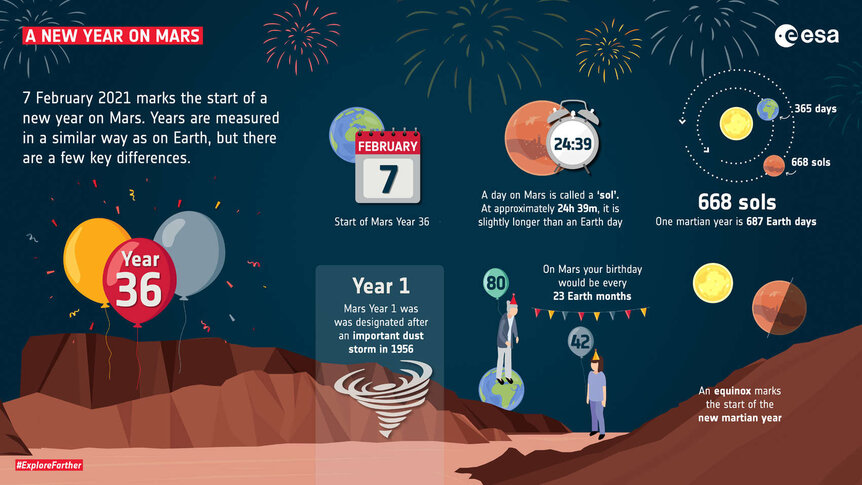Create a free profile to get unlimited access to exclusive videos, sweepstakes, and more!
Happy (Martian) New Year!

Happy new year! If you're a Martian!
When it's Sunday, February 7, 2021 on Earth it will be January 1, 36 (yes, just 36) on Mars: The first day of a new year.
It turns out this is based on science but is also somewhat arbitrary. I know that sounds like an oxymoron, but bear with me. This is fun.
Mars is the fourth planet from the Sun. On average it orbits about 228 million kilometers out, compared to 150 million for Earth. Because of that, it orbits more slowly and has a longer path to cover, so its year is longer than ours: about 687 (Earth) days compared to 365 and change for our planet.
Measuring the length of the Mars year is all fine and good, but when do you start that measurement? What day do you choose as Day 1?
In many countries (but by no means all) New Year's Day is January 1, and that's fairly arbitrary; Julius Caesar picked it to honor the god Janus, the god of beginnings, after whom January is named. There's no science behind this, no natural event to tag this with. He could have just as easily picked the first day of any other month*.
But with Mars we have a chance to do this right, and so scientists did. They decided to base the Martian calendar year after the tropical year, and start it on the northern spring equinox.
The tropical year is the time measured from spring equinox to spring equinox. For Earth, that's the 365.24 days you're probably used to hearing about (and it's what the calendar year is based on). For Mars, it's about 686.6 Earth days.
The equinoctes (yes, that's the plural for "equinox") and solstices are related to the axis of a planet's rotation. The spin axis of a planet tends to point in the same direction in space even as the planet revolves around the Sun. The summer solstice is the day on which the pole is tipped most toward the Sun (note that this happens in June for the northern hemisphere of Earth and December for the southern). The winter solstice is the day when the axis is most tipped away from the Sun. The equinoctes, then, are when the pole is pointed 90° away from the Sun.
Earth axis is tilted by about 23° from the plane of its orbit. By coincidence, Mars is tipped by about 25°. That means it has seasons similar to Earth's!
That gives us a nice date to pick for the beginning of the Martian year: Its northern hemisphere's spring equinox. It could've been one of the three other seasonal markers, but astronomers tend to use the vernal (spring) equinox for historical reasons.
The beauty of this is that the Martian vernal equinox is a physical event we can measure to determine this date. So, unlike our own calendar, one that could be (and possible one day will be) used on Mars will have a physical basis for its beginning. Cool.
Because Mars has a longer year, and it's not an even multiple of Earth's year, Martian New Year's Day is on a different Earth calendar day every time. In 2021 it will fall on our February 7.
As it happens, Mars orbits the Sun on an ellipse that deviates noticeably from a circle. This complicates things a bit. When Mars is at perihelion (closest point to the Sun in its orbit) it's moving a little bit faster than when it's at aphelion (farthest point). That means the seasons aren't all the same length, and they're off by quite a lot. Northern spring occurs when Mars is farthest from the Sun, so it's the longest season (about 199 Earth days long), and northern autumn the shortest (145 Earth days).
An aside: You might think that starting the year when a planet is at perihelion makes sense, and it in some ways does… but the time and date of perihelion can change. On Earth the gravity of the other planets tug on Earth and change the shape of its orbit, and the Moon exerts a decent force on the Earth, swinging it around and changing the exact time of perihelion every year. It's usually around January 4th (so close!) but that can change by several days from year to year.
Same for the equinox, which comes at a different time every year, so it doesn't make a great anchor for the start of the year. Worse, the number of days in a year isn't an even multiple, which is why we have leap years, and that makes things worse. In the end, pointing at a day and saying "Yeah, this one is the start of the year" works about as well and in many ways is simpler.
So the length of the year is a scientific one. But the year number — Mars year 36, in this case — is a little arbitrary. Year 1 was chosen to start on April 11, 1955, based on a paper published in (Earth year) 2000 about Martian seasonal temperature changes. As it happens, a big dust storm occurred in 1956 that was heavily studied from Earth, and this means it fell in Mars Year 1. Auspicious, and good enough to start a calendar with.
Later, Mars Year 0 was defined to start on May 24, 1953 — this was to allow the use of negative years, which is useful for scientists. That means human Martians sometime in the future will argue over when Mars centuries end, but so be it.
Which reminds me: The Martian day is a bit longer than an Earth day, by about 39 minutes. We call a Martian day a "sol" to distinguish them, and I know a few folks working with Mars rovers who have their schedule set by sols when they're on duty. After a few days I imagine that can get tricky, wanting to eat breakfast at lunchtime and so on.
Eventually people will live on Mars, and they'll have to deal with time, day, and even year conversions talking to people back on Earth. Various calendars have been put forth (and it's fun to figure them out), naturally, and one day one will have to be chosen as the official one. That may have to happen pretty soon, really.
That'll be an interesting sol for sure.
*You might think he would've picked July 1, since that month was named after him, but that was named in his honor after he died (it was called Quintilis before then), so there you go.

















